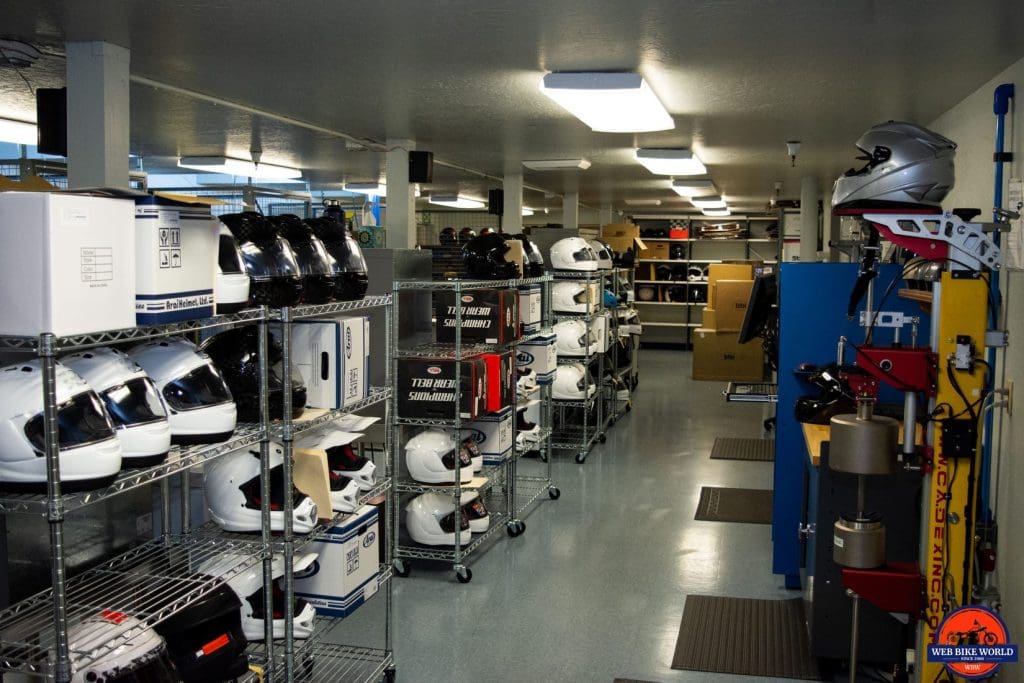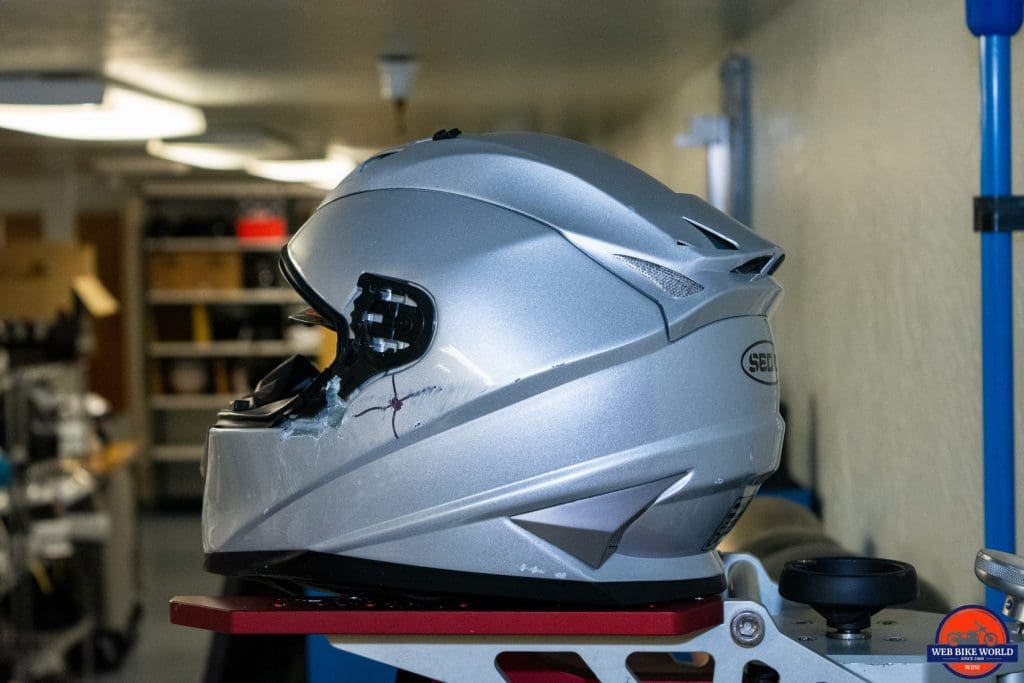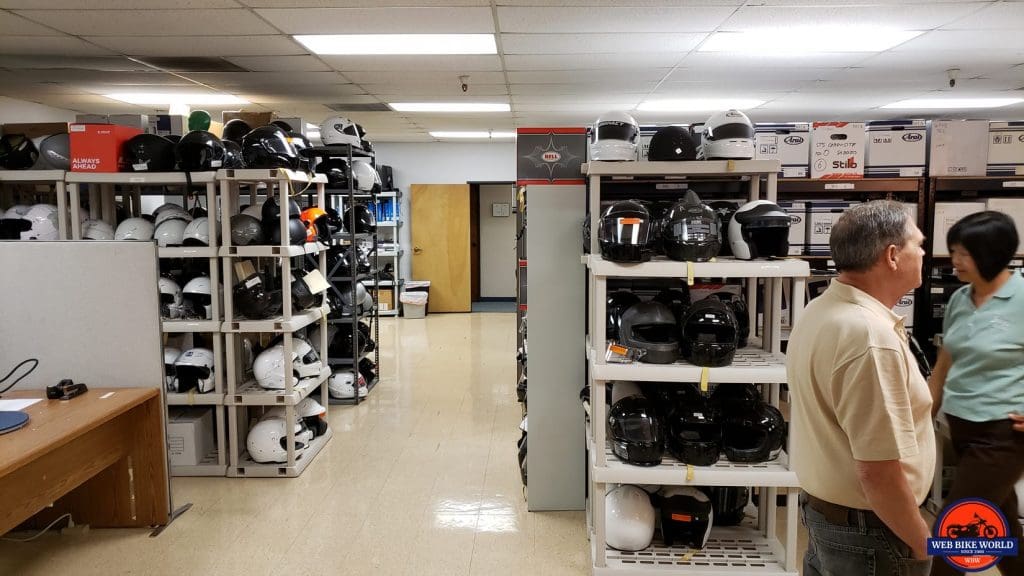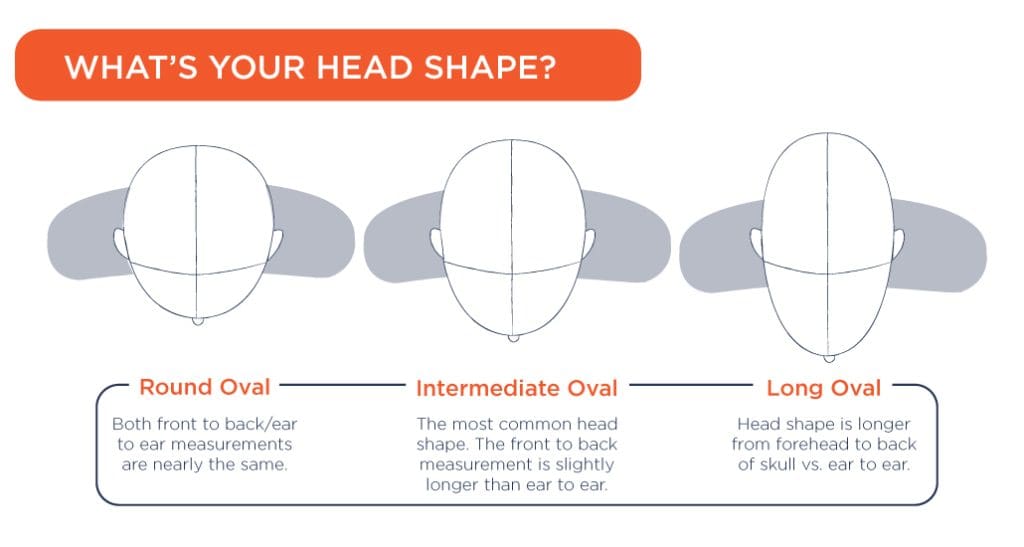The Snell Foundation is a non-profit organization that creates standards for helmets for vehicular activities including motorcycling. My colleagues Jim and Cameron went to the Snell Foundation’s headquarters last year to see exactly how the professionals there do their testing and create the standards that have a major impact on the motorcycle industry and the racing industry.
The foundation’s mission is dedicated to the research, education, testing, and development of helmet safety standards. This isn’t just for motorcycles. It also matters for automobile racing, karting, bicycle, equestrian, harness racing, and other sports that require helmets. Snell has standards for more than just motorcycle helmets. It’s been an important force in the helmet industry since its founding in 1957. It is recognized in the U.S. and around the world.
Every few years, Snell makes updates to its standard so that the standard continues to stay up to date and provide manufacturers with a standard to shoot for and consumers with a standard they know they can trust.
There is a new helmet standard for motorcycle helmets for 2020. It is called M2020, and will be the standard used moving forward. While it’s a lot like the previous Snell motorcycle helmet standard, it’s not the same, and because of this, we felt the need to take a detailed look at the new standard and tell our readers what it’s all about.
Differences Between Snell M2015 & M2020
Much of the M2015 report from Snell and the M2020 is the same. I also feel it important to note that just because a motorcycle helmet might be M2015 certified and not M2020, doesn’t mean it’s an unsafe helmet. The M2015 standard was a good one, and any helmet that has that rating will do a good job of protecting you.
The M2020 standard simply takes things a step further. It improves upon the already quality standard that Snell put out. That means there are some important updates to the standard.
M2020D and M2020R
One of the most important updates for the M2020 standard is that there are actually two standards for impact. There’s impact test options M2020D and M2020R.
The M2020D is for markets that use DOT. The “D” in M2020D stands for DOT, and it means that the impact standard will be the same as M2015. The M2020R is for other markets. The R in the standard name stands for Regulation 22.
Why have two impact standards? It’s a way for Snell to make a standard that applies to the entire world. Snell said it best in its explanatory cover letter. I’ve included that explanation below:
“Industry leaders have urged that M2020 ought to enable continued production of configurations developed for M2015 compliance. They maintain and Snell agrees that these demands reflect the most impact energy management possible in a motorcycle helmet consistent with motorcyclists’ needs and with the requirements of mandatory standards in the United States and Japan. M2020D is formulated to serve this purpose. However, since M2015 demands complicated compliance with mandatory standards in place in Europe and other parts of the world, this M2020 draft allows a second impact test option, M2020R, with test severities are chosen to identify headgear with the greatest impact energy management consistent with motorcyclists’ needs and with the requirements of ECE Regulation 22 (ECE 22-05). It is hoped that M2020R will also enable compliance with FRHPhe-01 which will apply to helmets used in FIM sponsored competitive events.”
So, in essence, it’s a response to the industry’s response to FIM safety standard for competition and the new ECE regulations. Snell sees both ECE and FIM standards to be inadequate and has offered a special M2020 standard because of that. I see this as a good thing and a way for the standard to be used around the world.
The discrepancy between the standards comes down to this. Some consider the liner of a Snell-approved helmet to be too hard. They would prefer a softer helmet liner to absorb more energy. In concept, this makes sense, but the issue is that a higher speeds or if the helmet comes into contact with a sharper object, that softer liner can be problematic. Snell’s standard protects the head for higher-level impacts.
It really comes down to the individual accident you have. For example, an ECE helmet might be just fine if you’re on a scooter or small-displacement machine and go down at a low to moderate speed. However, if you’re traveling a highway speed, or collide with another vehicle the Snell helmet is likely to protect you better.
Still, because ECE is a government standard, Snell needs to offer a solution that will work with ECE. Hence the two standards: M2020D and M2020R.
Testing Helmets Differently

Because there are two different standards now, the testing for these standards must be conducted differently. This should make perfect sense. Two standards mean two testing protocols.
According to documentation from Snell, the M2020D (Continuation of M2015 Requirements) require the following tests:
- Flat Anvil – two impacts, the first at 7.75 m/sec and the second according to the test head form.
- Hemispherical Anvil – same as the flat.
- Edge Anvil – a single impact at 7.75 m/sec.
- Test Criteria – the recorded shock must not exceed the peak G level set for the test head form.
The M2020R (Consistent with European Demands (ECE 22-05) and with FIM FRHPhe-01) standard requires the following tests:
- Flat Anvil – a single impact at 8.2 m/sec
- Hemispherical Anvil – two impacts, the first at 7.70 m/sec and the second according to the test head form.
- Edge Anvil – a single impact at 7.75 m/sec.
- Test Criteria – the recorded shock must not exceed the peak G level set for that head form and the HIC calculated for the shock pulse must not exceed 2880.
- Although Snell’s directors have concluded that HIC is of little use in evaluating helmet protective capability, they agree that M2020R must still assure some reasonable compliance with the HIC criteria imposed in ECE 22-05 and in FRHPhe-01 and that applying a HIC criterion in M2020R may be the best way to obtain this assurance.
It’s important to note that all helmets will have to undergo the following:
- Provide a premium of protective capability
- Comparable in weight and bulk to helmet models currently certified to M2015
- Comparable in costs to helmet models currently meeting M2015.
- Capable of meeting mandatory requirements
- M2020D – intended to enable DOT and/or JIS as required in North America and Japan
- M2020R – intended to also enable ECE 22-05 and FIM FRHPhe-1 as required in Europe and elsewhere
These changes from the Snell M2015 standard to the M2020 standard should lead to better and safer helmets for years to come.
Timeline for Snell M2020 Implementation
When it comes to implementation of the M2020 standard, the date set was October 1, 2019. The stickers shipped on April 1, 2019. Most racing organizations that actually require Snell will allow riders and drivers with the current and the next most recent standards to participate in racing.
In the case of M2020, this would mean the M2020 standard and the M2015 would both be allowed at events, but helmets that are Snell 2010 may not be. You should check with the racing organization to be sure that you have a helmet that is approved for participation.
Details of the Snell M2020 Standard

Let’s take a closer look at the new standard and check out some of the details from the document itself. This is not a word for word reproduction of the standard but is instead my own version of it.
I have tried to parse the information and make it more easily digestible. If you want to see the real documentation, then you should check out the standard itself. I warn you, though, it can be kind of dense.
General
Snell’s M2020 standard is looking for a smooth shape overall. It notes that any protrusions “7 mm beyond the outer surface must readily break away.” On the flip side, anything (like a rivet) that goes into the helmet must not pose any potential hazard.
Also, add-ons or accessories (visors, neck curtains, face shields) can’t compromise the safety of the rider.
Shell
The shell of the helmet, again, needs to be smooth overall, and any rivets can’t be sharp or stick out beyond 2mm.
Materials
The material of the helmet’s interior should “not be harmed by exposure to sun, rain, dust, vibration, sweat or products applied to the skin or hair.” It can be removable, and it should not be known to be a material that is in any way dangerous or prone to high levels of bacteria.
It’s this part of the standard that encourages companies to use moisture-wicking, antimicrobial liners that are removable and washable.
Finish
The finish refers to more than just the paint. It’s about the smoothness of the exterior overall, even the metal parts. If there’s something that’s rough or could damage the rider in an accident, Snell won’t let that fly.
Retention System
Chin straps are what we’re talking about here. Quick-release ones can be used but they can’t be something that can be easily released on accident. Also, fabric chin straps can’t be designed in a way where they might rip. Snell advises manufacturers to secure straps with a “metal hanger” that is then bolted to the shell.
Peripheral Vision
The numbers for peripheral vision are clear. Snell puts them right out there. Here they are: horizontal clearance of at least 210 degrees, an upward clearance of at least 7 degrees, and a downward clearance of at least 30 degrees.
Sizing
Because many helmets perform better at certain sizes than others, Snell requires that all of the sizes be listed when a helmet is trying to earn certification. Also, after the testing is complete the helmet must have a permanent label that lists the circumferences of a person’s head it is designed to work with properly.
Finding the Right Helmet for You

In terms of finding the right helmet, I’d highly recommend a Snell certified helmet. They offer fantastic levels of protection. However, I do have to note the increase in price. Snell certification comes with a notable price hike.
You will have to decide for yourself if the hike in price is worth it. I would recommend you spend the money and be on the safe side, but I do feel there are plenty of very nice helmets out there that lack Snell certification. As was mentioned above, the right helmet for the job depends on the crash you have (if you have one). While Snell will better your chances of staying safe no matter what, there’s always an inherent risk whenever you throw a leg over a bike. At the very least wear a DOT-approved helmet, but if you can, get a Snell certified one.
Helmet Types
Full-face helmets are the ones you’ll see with Snell certification—though Snell will certify others if they can pass the standard. Full face helmets are also the safest helmets you can buy. Personally, I find these to be the most comfortable, too. Are they the most convenient? No. I’d say modular helmets are.
Here are the types of helmets and a link to some of our recommendations and reviews on helmets of each type.
Head Shape

You’ll also need to think about the shape of your head and the shape of your helmet. Generally, helmets are made to fit three different head shapes: round oval, intermediate oval, and long oval.
Most riders have an intermediate oval head shape. This means you’ll find the most helmets out there, especially in North America, with an intermediate oval head shape.
Keep in mind that these head shapes are just guidelines. No helmet is going to fit you absolutely perfectly, but by going with the head shape and correct size, you should have a lid that will feel comfortable to wear hour after hour of riding.
Head shape plays no role in Snell certification. Helmets of all head shapes have passed the standard, and that means you should be able to find a Snell certified helmet no matter what shape head you have.
If you have more questions about helmets and finding the right helmet for your valuable noggin’, then check out our motorcycle helmet buying guide where we walk you through every part of the process.
If you have questions about Snell or the helmet standard, then I suggest you go to the Snell Memorial Foundation website.



Who devised regulation. 22 and by which methods?
If snell are any authority, they need only produce 1 worldwide standard, surely?
Anyway,
Helmet certification, standards and testing are a joke.
What expertise do you have to suggest helmet standards are not useful?
The ECE-22 standard is in effect across the European Union, just as DOT is in effect across the US. Any helmet sold in the EU must be ECE-22 compliant, and tested to ensure it conforms.
Since a Snell-approved helmet must also have the requisite jurisdictional (DOT or ECE-22) to be sold, it wouldn’t make sense for Snell to have a standard that would preclude it passing the ECE or DOT standard. Their modification of their standards to meet the ECE standard, while it doesn’t agree with their safety philosophy, is essentially not a choice, but a requirement.
NOT adjusting their standards in non-ECE countries allows them to adhere to what they believe are the best safety standards, and not compromising those where not needed make perfect sense in a moral and ethical sense.
Bullshit. If they believe their safety philosophy superior than ECE and helmet can’t met both standards – they should leave European market, not make separate weak(according their safety philosophy) standard. But “money doesn’t smell”, right?
I prefer Snell-Certified Helmets because I know Snell tests all helmets it certifies; DOT only spot checks helmets for compliance. DOT is basically self-certification by the manufacturer. In any event, any certified helmet is better than no helmet at all.
While standards are helpful – because they provide a bare minimum requirement – I like to look at the UK’s SHARP test results when choosing a helmet. The SHARP ratings give a comparison, so I can see how well one helmet protects relatively to another. And France’s Certimoov ratings are useful too. They are all helpful info (to supplement comfort and fit).
but you have to keep in mind that the helmets in those tests are European models. I’ve checked with HJC and Bell and their European models and different from the US ones, so if you’re buying a US helmet those results may not be too useful.
Can you give a comparison to how the Snell M2020D compares to ECE 22.06, or the FIM standard? All the different standards are a bit confusing to read about, and to actually determine which helmets are safer overall. For example, the new RF 1400 is Snell M2020D, and the new Arai Quantic is ECE 22.06 approved. Which is technically “safer”?
One thing Jim and I learned during our visit to Snell: the safest helmet is the one that fits you the best and you will wear. I know that’s a shoddy answer, but Ed Becker @ Snell insists that it’s true.
In terms of what is safer – ECE and Snell – that’s going to be a hard one to quantify. Again, while at Snell, they made it clear that a DOT/ECE approved helmet was safe so long as it has been taken care of (IE- not damaged enough to dent the shell/protective material inside).
Let me think on how to approach this topic. It’s a great idea, but honestly, I’m currently at a loss on how we could reasonably test it.
Hi Joseph!
You’ve stepped into deep waters trying to wrap your head around all these certification standards. I’ve been working on it for about 3 years now and admit that I still don’t have a complete grasp on it all, but I think I’ve got a general understanding that I can attempt to share without going overboard.
Here’s a link to a summary of the changes to ECE 22.05 that we can expect in ECE 22.06 as interpreted by Koroyd. I like the way they break it down. Scroll to the bottom to see the summary chart> https://koroyd.com/journal/new-motorcycle-helmet-safety-standards
This is more easily digested than the actual 22.06 rollout which has a lot of stuff in it that will make your eyes gloss over. https://unece.org/fileadmin/DAM/trans/doc/2020/wp29/ECE-TRANS-WP29-2020-060e.pdf
Here’s my personal take on it. None of these standards are “safer” than another in reality because standards should be exceeded, not just met. Unfortunately, we don’t get to see the exact numbers for testing even from Snell to know whether the helmet passed by a longshot or the width of half a hair. That irritates me and is why I often check the SHARP website when looking at helmet safety ratings. Unfortunately SHARP only tests ECE versions of helmets, so that doesn’t help us here in North America very much because our helmets are DOT versions much of the time and the philosophy of DOT falls more closely to the opposite of ECE.
DOT philosophy is generally to build a “hard” shell helmet that resists entry of G forces first and foremost.
ECE philosophy is generally around building a “soft” shell helmet to absorb all the energy before it gets to the wearer’s head.
Both systems work very well, but do it differently depending on the rationale of the people who originally designed the specifications.
Snell standards tend to follow the DOT ideology but take it to a much, much higher level, which sacrifices a little bit of protection in lower speed crashes, but make up for it in a higher speed crash where they protect noticeably better than a DOT or ECE approved helmet.
From what I understand the M2020D standard is more or less the same as M2015 was and that wasn’t a whole lot different than M2010 was. Snell says we’re just about maxed out on the limits of protection available until some new developments in materials appear. I’m hoping Koroyd is that development, but as of yet, it remains unproven by an independent testing facility for some strange reason.
How does M2020D compare to ECE 22.06? They’re still different ways of achieving the same amount of head protection, but the ECE testing includes angled impacts that Snell doesn’t do. I’m pretty confident the M2020D certified helmets would perform just about as well if they were subjected to angled impacts, but I’m only guessing.
The M2020E standard is interesting though because Snell appears to have changed their testing to better follow the ECE 22.06 rationale. Additionally, it appears ECE 22.06 has changed some of their specs to move closer to what Snell standards look for. We won’t get M2020E certified helmets here in North America though, but you could order them from Europe, or at least we can here in Canada because we’re legally allowed to use ECE only helmets here. We don’t require DOT certification. Funny that eh?
FIM is yet another fun one to look at that I haven’t truly come to understand just yet, unfortunately. That standard appears to be quite similar to ECE 22.06 from what I can see and that’s perhaps why ECE has updated their standards? 22.05 is over 20 years old after all, so it was due for tweaking. DOT is 10 times more due for an update considering it’s waaaay older than that.
Snell says FIM has problems when it comes to their acceptable impact forces allowable, but Snell says that about ECE as well… that is they did say that last year to me and Cam, and then they turned around and developed M2020E certification.
Ok so which is safer the Shoei RF-1400 or the Arai Quantic ECE 22.06? Very difficult question to answer especially since we don’t yet know if the Arai will be M2020E certified. I suspect strongly it will be although my Arai Americas contacts weren’t able to answer me when I asked them.
I can tell you this for sure, the RF-1400 M2020D will be very good in a high speed crash and better than most helmets even in a low speed crash because I know Shoei builds helmets that exceed all kinds of certification standards.
So does Arai, though. If you haven’t read my article called Arai Is The Helmet To Buy then you should and it will conclude that Arai might be the safest helmet to wear based on their history.
However, Shoei helmets score slightly higher on average in SHARP testing… but again those are ECE helmets and not the DOT compliant ones we wear here in North America.
That’s why in the end this is a really long-winded way of confirming what Cam already told you: buy the helmet that fits you better and that will be the slightly safer helmet. Fit can’t be undersold as a safety factor. It’s paramountly essential and everyone from Ed Becker at Snell, to Michio Arai, will tell you that. Even the people at FIM, ECE, and SHARP will back that up.
If traditionally Shoei helmets have fit you better than Arai helmets then go for the RF-1400 which is available right now instead of waiting for the yet-to-arrive Quantic. If Arai helmets fit you better (as is the case with me personally), then it may be worth waiting.
I’m very impressed with the RF-1400 thus far in my testing. It’s easily in my top 5 helmets, but I’m also confident the Quantic will grab a spot in that as well.
Now I’m sure you regret ever asking that question! lol
… Sorry I forgot to explain that I lean slightly more towards saying Arai is safer than Shoei because they do focus a bit more on fitment. That’s why it’s going to be such a toss up for me going forward when I decide whether to wear my RF-1400 or Arai DT-X. The Arai fits me a little bit better than the Shoei.
It’s complicated and yet simple all at once.
I’ll have to disagree with the presumption that the Snell cert results in a safer helmet. Based upon the summary comparative info provided in the article, ECE 22.05 tests against a higher initial impact for the flat anvil shape (8.2 m/s vs 7.75 m/s) although the Snell requires a 2nd impact where as the ECE cert does not. However, the ECE cert requires a 2nd impact against a hemispherical shape whereas Snell does not. Secondly, a glaring omission from the article is a comparison of the allowed G-force permitted to be transmitted to the head form by the Snell and ECE certifications for each impact test. And lastly, I’d rather purchase a helmet certified by an authority which takes into account the complete science regarding brain trauma (i.e., rotational forces). My understanding is that the ECE 22.06 standard is attempt to address rotational effects upon the brain.
Also, Arai helmets have not, until recent design changes regarding the face shield mechanism, faired all that well in the British SHARP testing protocols.